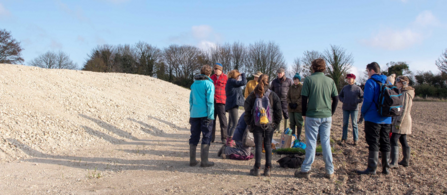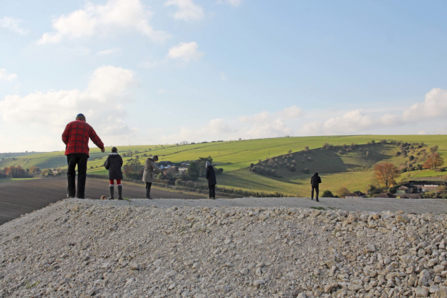The gleaming white slopes of the new butterfly bank at Wiltshire Wildlife Trust’s (WWT’s) Coombe Bissett Down nature reserve have been bustling with life recently, with a team of dedicated volunteers attending the Trust’s ‘Scatter and Natter’ event.
Scattering and Nattering at Coombe Bissett Down

Armed with seeds, plug plants, tools, and kneeling pads, a team of volunteers and WWT staff headed to the bare banks of chalk to plant and scatter wildflowers and seed. The chosen species (horseshoe vetch, kidney vetch, and bird’s-foot trefoil) will thrive on the steep slopes of the bank.
As well as developing into a striking wall of colour, the plants will be an essential food source for the larvae of priority butterfly species: the Adonis blue, which feeds on horseshoe vetch; the small blue, which feeds on flowerheads of kidney vetch; and the dingy skipper, which feeds on bird’s-foot trefoil and yellow horseshoe vetch. The Trust hopes that this work will help support these species, which are found in small populations on the reserve but part of the generally declining insect population.
Amongst the bags of seeds and plug plants was a tray of rock rose seedlings. These delicate-looking plants, popular with pollinators, were raised by a WWT volunteer from seeds taken from the reserve.
With the sun shining, everyone was in high spirits. From atop the S-shaped curve of chalk, where a steady line of brightly coloured coats snaked along scattering seed, one local dog walker attending with her daughter said that they were “proud to be able to support the project.”
The teams were given the chance to swap roles during the morning, so that those scattering seed could try their hand at planting plugs directly into the chalk and vice versa. For some, this was their first time getting involved with the Trust; with good weather and plenty of good company, this was a fantastic first event to attend.
There was a real sense of community and pride in the work being carried out, as well as a resounding sense of hope for the future, with one volunteer saying that they were “looking forward to visiting the area over the next few years to see the legacy we’ve left.”
Sowing 4.5 kg of seed and planting 300 plugs is no mean feat, and the warming soup lunch provided at the local village hall was well received. It was also a chance for everyone to sit down together in the warm and discuss their experiences from the morning. One volunteer spoke very highly of the whole experience, saying the event was “amazing” and the project “superb.”
As well as local volunteers getting stuck in, there were a few who had travelled from further afield. Inspired by the success of other butterfly banks they had heard about, two volunteers travelled from Swindon to help with the day’s tasks. Whilst this was their first visit to the reserve, they already have plans to return to see the results of their efforts.
Melanie Evans, the Trust’s Community Engagement Officer, was pleased with the turnout and said that it was lovely to see new faces. She hopes that this event, and the butterfly bank itself, will encourage people to return to the reserve to see the ongoing progress of the Coombe Bissett Down Project, which is supported by the National Lottery Heritage Fund.

Although the bank has now been sown, the hard work doesn’t stop there. The Trust are on the look-out for volunteers to help monitor the establishment of wildflowers as well the butterflies and insects attracted to them. There are also a number of further events planned, so be sure to keep an eye on the project's events page and WWT’s social media accounts (Facebook and Twitter).

